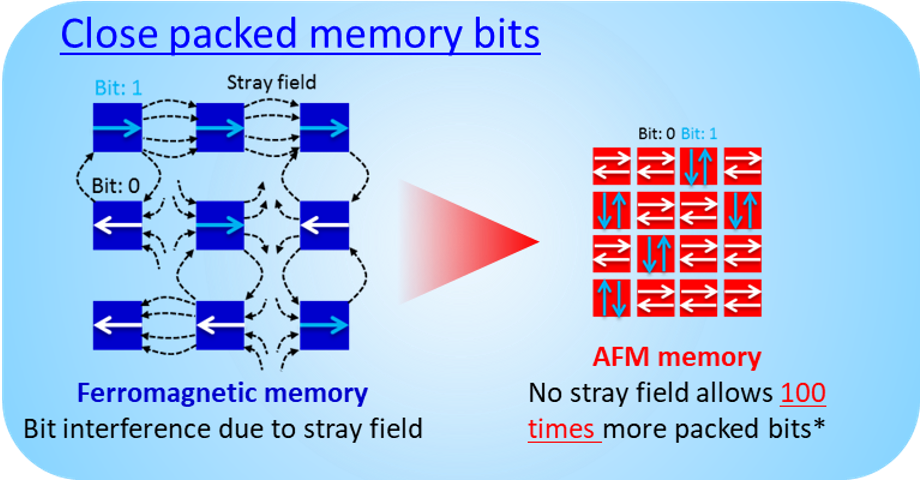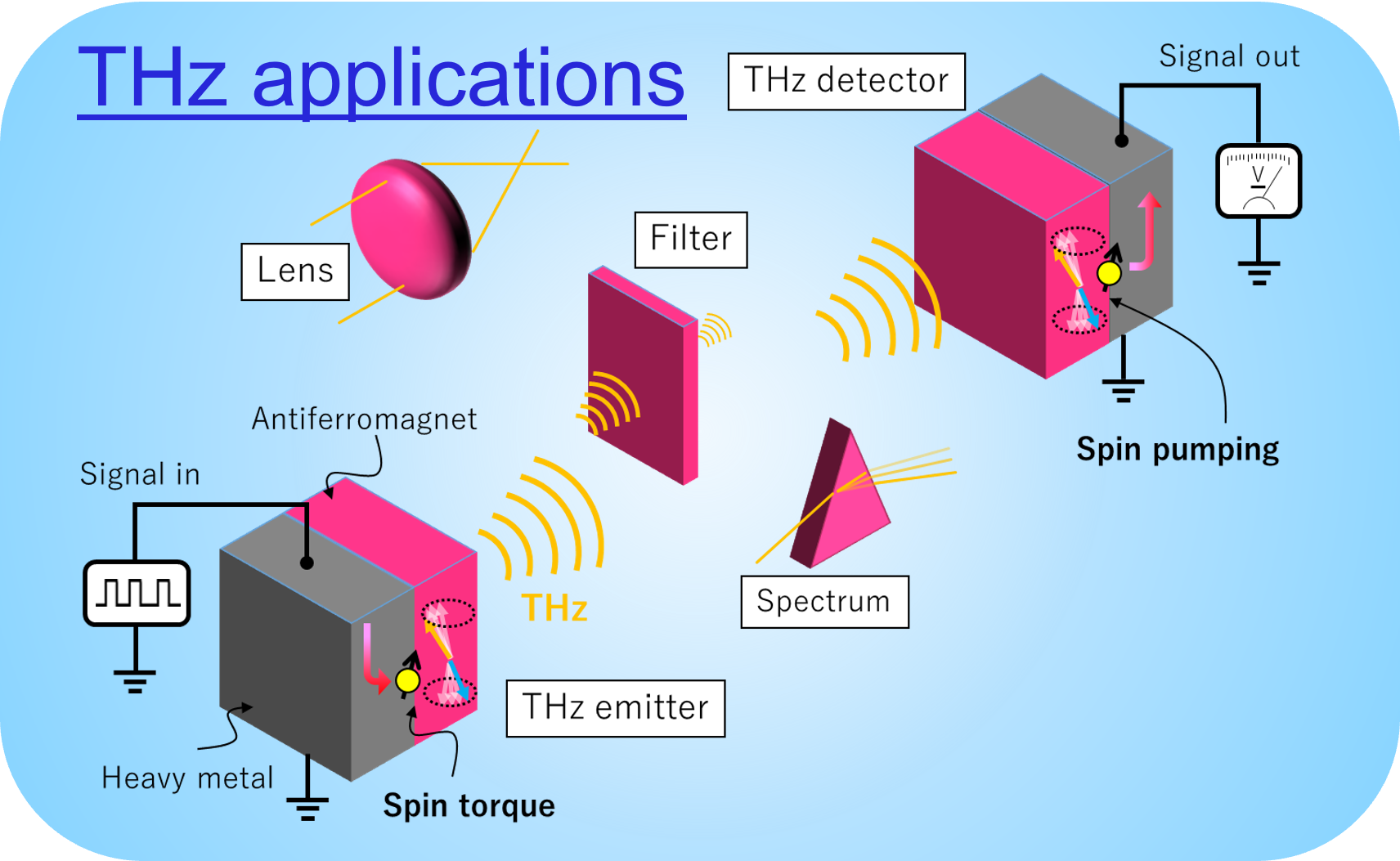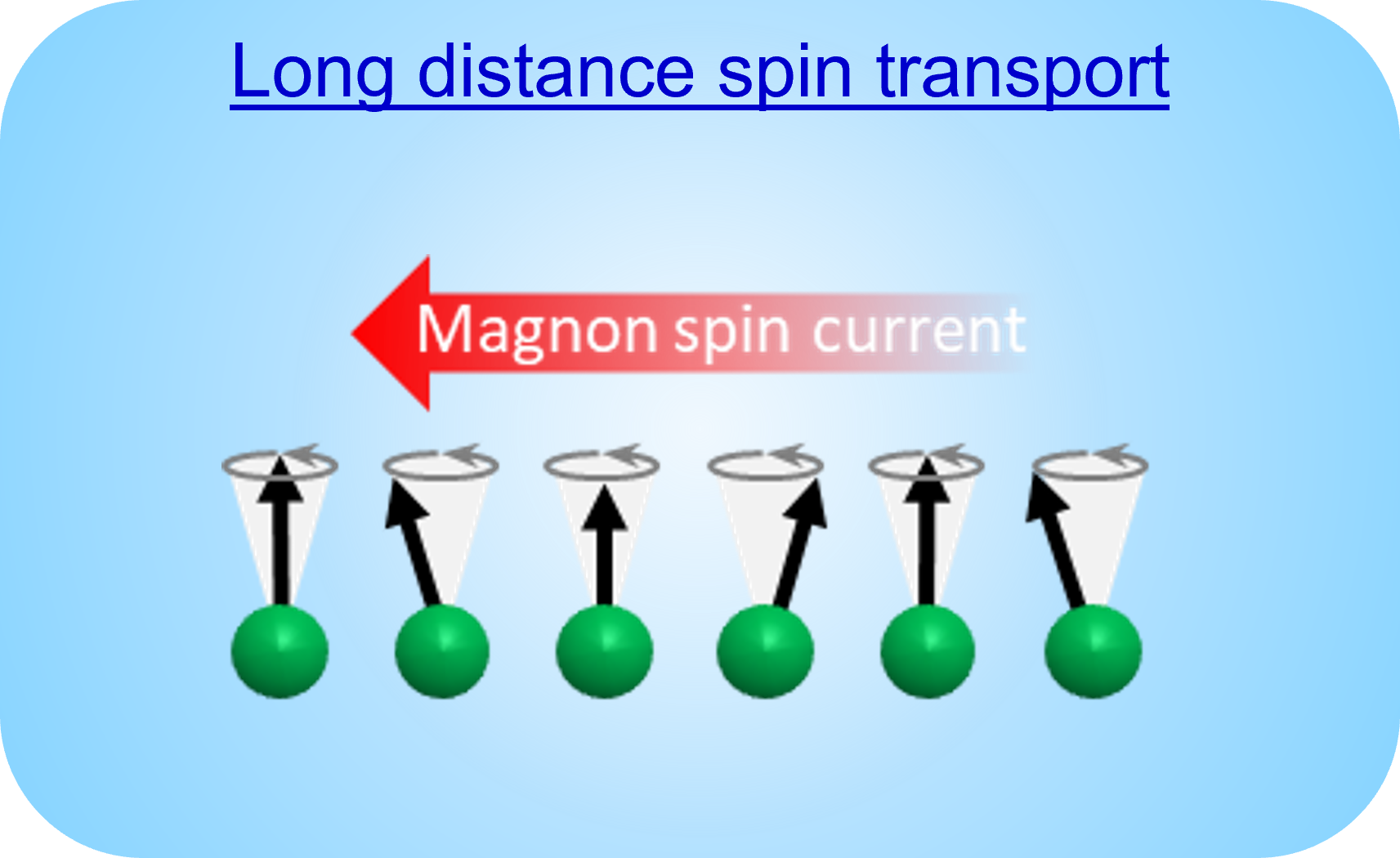Research topics
Antiferromagnetic spintroncis
 For a long time, there have been no efficient ways of controlling antiferromagnets. Quite a strong magnetic field was required to manipulate the magnetic moments because of a high molecular field and a small magnetic susceptibility. It was also difficult to detect the orientation of the magnetic moments since the net magnetic moment is effectively zero. Nevertheless, the microscopic magnetic moments should in principle exhibit a similar spintronic effect as seen in ferromagnets. Recent vigorous research effort has demonstrated various interesting spintronic phenomena with antiferromagnets some of which indeed could not be found in ferromagnets. We have investigated and quantified spin current interactions in various antiferromagnets [1-3], demonstrated antiferromagnetic memory devices [4,5], and explored antiferromagnetic domains by XMLD-PEEM. These results are proving that antiferromagnets, previously considered useless, are actually useful materials in spintronics. Now, antiferromagnetic spintronics [6] is recognized as one of the exciting research subfields in spintronics.
For a long time, there have been no efficient ways of controlling antiferromagnets. Quite a strong magnetic field was required to manipulate the magnetic moments because of a high molecular field and a small magnetic susceptibility. It was also difficult to detect the orientation of the magnetic moments since the net magnetic moment is effectively zero. Nevertheless, the microscopic magnetic moments should in principle exhibit a similar spintronic effect as seen in ferromagnets. Recent vigorous research effort has demonstrated various interesting spintronic phenomena with antiferromagnets some of which indeed could not be found in ferromagnets. We have investigated and quantified spin current interactions in various antiferromagnets [1-3], demonstrated antiferromagnetic memory devices [4,5], and explored antiferromagnetic domains by XMLD-PEEM. These results are proving that antiferromagnets, previously considered useless, are actually useful materials in spintronics. Now, antiferromagnetic spintronics [6] is recognized as one of the exciting research subfields in spintronics.
[1] T. Moriyama et al., Phys. Rev. Lett. 119, 267204 (2017).[2] T. Moriyama et al., Phys. Rev. Appl. 11, 011001 (2019).[3] H. Masuda et al., Commun. Mater. 1, 75 (2020). [4] T. Moriyama et al., Sci. Rep. 8, 14167 (2018). [5] T. Moriyama et al., Phys. Rev. Lett. 121, 167202 (2018). [6] V. Baltz, T. Moriyama et al., Rev. Mod. Phys. 90, 015005 (2018); T. Jungwirth et al., Nat. Nanotechnol. 11, 231 (2016).
THz spintroncis
 In antiferromagnetic spintronics where manipulation of the antiferromagnetic spins is a central technological challenge, it is important to understand the dynamic properties, especially their THz spin dynamics and the magnetic damping [1]. While both experimental and theoretical investigations of the antiferromagnetic resonance began in 1950s, they have been recently revisited with more advanced experimental techniques as well as with more rigorous theoretical treatments. We have recently reported series of experimental results regarding THz dynamic properties of antiferromagnetic materials focusing on the relaxation dynamics. We have explored frequency-domain THz spectroscopies of antiferromagnetic NiO and detail quantitative analysis of the antiferromagnetic damping [2], control of the antiferromagnetic resonance properties by various cation substations [3], and observation of the THz spin pumping effect [4], and. These results are important milestone for future THz antiferromagnetic spintronics.
In antiferromagnetic spintronics where manipulation of the antiferromagnetic spins is a central technological challenge, it is important to understand the dynamic properties, especially their THz spin dynamics and the magnetic damping [1]. While both experimental and theoretical investigations of the antiferromagnetic resonance began in 1950s, they have been recently revisited with more advanced experimental techniques as well as with more rigorous theoretical treatments. We have recently reported series of experimental results regarding THz dynamic properties of antiferromagnetic materials focusing on the relaxation dynamics. We have explored frequency-domain THz spectroscopies of antiferromagnetic NiO and detail quantitative analysis of the antiferromagnetic damping [2], control of the antiferromagnetic resonance properties by various cation substations [3], and observation of the THz spin pumping effect [4], and. These results are important milestone for future THz antiferromagnetic spintronics.
[1] T. Moriyama et al., J. Phys. Condens. Matter 33, 413001 (2021). [2] T. Moriyama et al., Phys. Rev. Mater. 3, 051402 (2019). [3] K. Hayashi, T. Moriyama et al., Appl. Phyis. Lett. 119, 032408 (2021). [4] T. Moriyama et al., Phys. Rev. B 101, 060402 (2020).
Magnonics: long distance spin transport
 Magnonics is an emerging field of magnetism that encompasses the investigation and control of spin wave excitations (magnons), which is a collective excitation of spin dynamics, as carriers of spin information in nano-structures[1]. In general, spin information diffuses and decays as it travels. Therefore, it is important to have materials with low spin current dissipation (or low magnetic damping). We have recently found that a long distance spin transport in antiferromagnetic NiO which is associated with propagating magnons [2-4].
Magnonics is an emerging field of magnetism that encompasses the investigation and control of spin wave excitations (magnons), which is a collective excitation of spin dynamics, as carriers of spin information in nano-structures[1]. In general, spin information diffuses and decays as it travels. Therefore, it is important to have materials with low spin current dissipation (or low magnetic damping). We have recently found that a long distance spin transport in antiferromagnetic NiO which is associated with propagating magnons [2-4].
[1] T. Moriyama et al., J. Phys. Condens. Matter 33, 413001 (2021). [2] T. Moriyama et al., Appl. Phys. Lett. 106, 162406 (2015). [3] S. Takei, T. Moriyamm et al.,Phys. Rev. B 92, 020409R (2015). [4] T. Ikebuchi, T. Moriyama et al., Appl. Phys. Exp. 11, 073003 (2018) and Appl. Phys. Exp. 14, 123001 (2021).
Spin-orbitronics

 Quantum Spintronics
Quantum Spintronics 